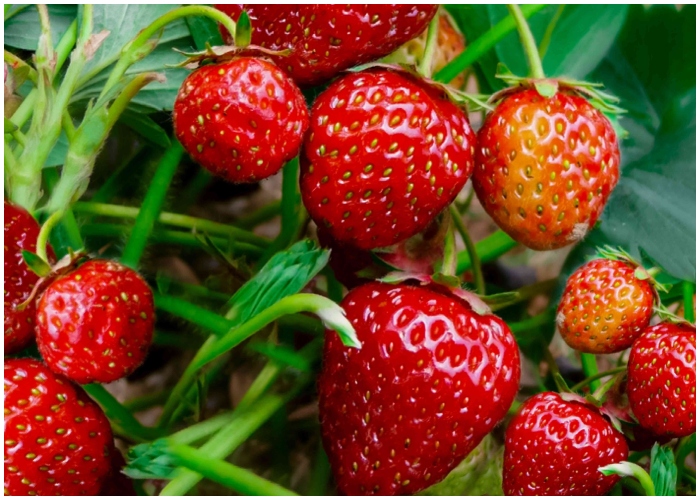Growing strawberries is a gratifying experience for any gardener, rewarding you with sweet, juicy fruits right from your backyard or balcony. Strawberries are versatile, thriving in gardens, raised beds, and containers, making them accessible to growers with various space constraints. Here’s an in-depth look at how to successfully cultivate strawberries, ensuring a bountiful harvest.
Optimal Soil and Planting Techniques
- Soil Requirements:
- Strawberries prefer well-drained, fertile soil with a slightly acidic pH between 5.5 and 6.8. Before planting, test your soil’s pH and adjust accordingly using sulfur to lower the pH or lime to raise it if necessary.
- Enhance native garden soil by incorporating several inches of aged compost or other rich organic matter. This amendment improves soil structure, drainage, and nutrient content.
- Planting Guidelines:
- Depending on your climate, strawberries can be planted either in the spring or fall. Spring planting is advised for colder regions (zone 6 and northward) to ensure that plants are well-established by winter. In warmer regions (zone 7 and southward), fall planting takes advantage of mild winter temperatures for a vigorous start.
- Space strawberry plants about 18 inches apart in rows, with the rows spaced approximately 2 feet apart. This spacing allows adequate room for runners and ensures good air circulation, which is crucial for disease prevention.
- Plant each strawberry so that the soil covers the roots but leaves the crown (the part of the plant where the leaves emerge) exposed. This placement is crucial as burying the crown can cause the plant to rot.

Sunlight and Watering Needs
- Sunlight: Strawberries require at least 8 hours of direct sunlight per day. The more sunlight they receive, the greater the harvest and the sweeter the berries.
- Watering: Provide strawberries with about 1 to 1.5 inches of water weekly, more if you’re in a hotter, drier climate. Water deeply and infrequently to encourage strong root growth. Avoid overhead watering to reduce the risk of leaf diseases.
Fertilization and Maintenance
- Fertilization: Start with a balanced, continuous-release fertilizer at planting. This initial feeding supports early growth and fruit development. Throughout the growing season, reapply a strawberry-specific or general fruiting plant fertilizer according to package instructions to maintain nutrient levels.
- Weeding and Mulching: Keep the strawberry beds free of weeds, which compete for nutrients and water. Mulching with straw or pine needles helps retain soil moisture, suppress weeds, and keeps the berries clean. Black plastic mulch can also be used to warm the soil, speed up early growth, and block weed growth.
Managing Runners and Renovating Beds
- Runners Management: Most strawberry varieties produce runners. To maximize fruit production, limit each plant to producing just two or three runners. Pin these runners into the soil where you want them to root or clip excess runners to focus the plant’s energy on fruit development.
- Bed Renovation: After the harvest season, renovate your strawberry beds by thinning out older plants and keeping only vigorous, healthy young plants. This practice encourages productivity and reduces disease incidence.

Protecting from Pests and Diseases
- Pest Control: Common strawberry pests include slugs and birds. Use environmentally friendly slug baits or barriers for slugs, and protect ripening berries from birds with netting.
- Disease Prevention: Promote good air circulation by not overcrowding plants and by keeping the foliage dry. Remove any diseased or dead plant material promptly to prevent the spread of fungal diseases.
Harvesting and Storage
- Harvest strawberries in the cool of the morning when they are still firm. This practice helps extend their shelf life. Pick the berries with the caps still attached and store them in the refrigerator soon after picking. Wash the strawberries just before you plan to eat them to prevent them from absorbing water and becoming mushy.
- For an extended harvest, consider planting different strawberry varieties. June-bearing stock produces a large, concentrated crop in the late spring or in the early summer, everbearing types produce two to three harvests throughout the season, and day-neutral varieties produce fruit continuously throughout the growing season.
Enjoying Your Strawberries
With proper care, strawberries can become a perennial feature in your garden, producing delicious fruits year after year. Whether you grow them for fresh eating, jams, or desserts, strawberries bring a rewarding experience to gardening efforts with their vibrant color and sweet flavors.
Incorporating these practices will not only help you grow healthy strawberry plants but also maximize your yield and fruit quality, making your gardening project a delicious success.